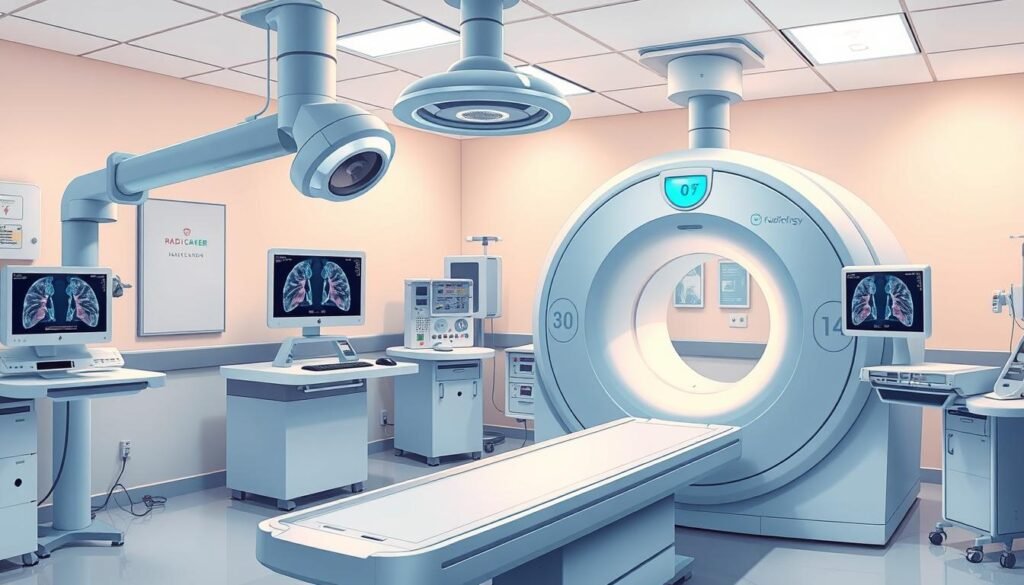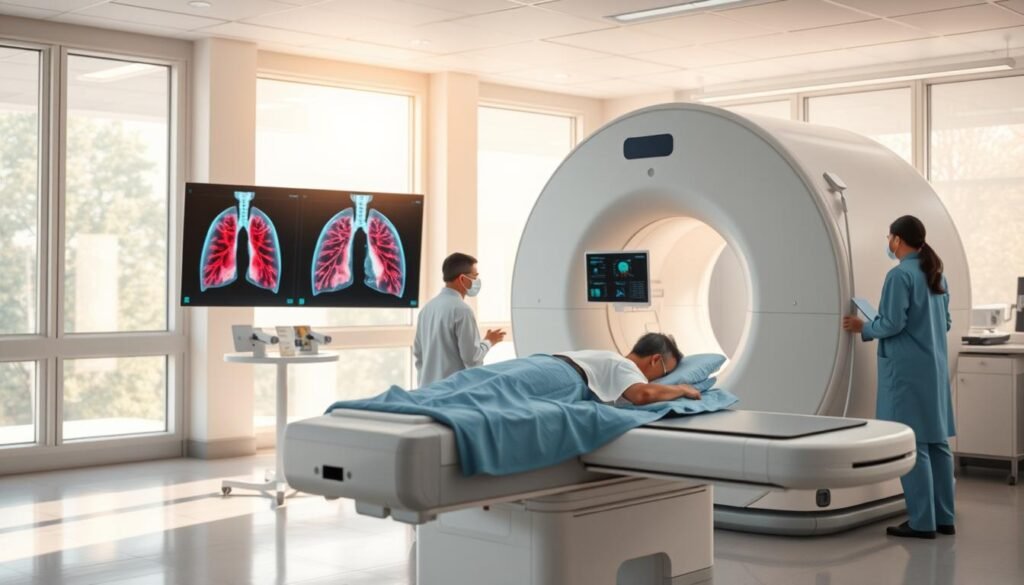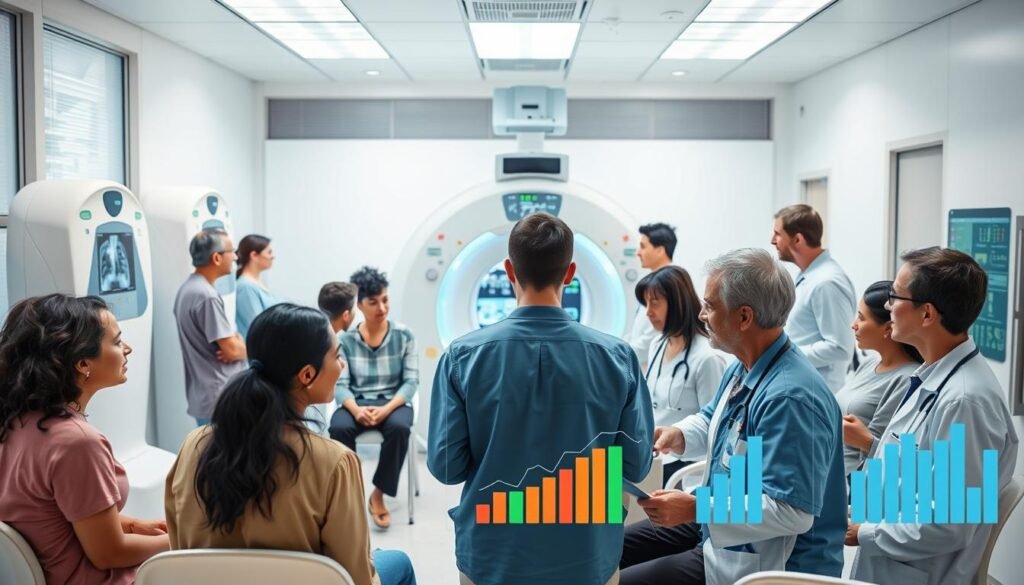Did you know the average American gets about 3 mSv of radiation yearly from natural sources? But, a single CT chest scan can give an effective dose of 7 mSv. This shows how important medical radiation, like X-rays and CT scans, is in finding and handling lung cancer. Lung cancer is a top cause of death from cancer. It’s vital to understand these imaging methods. Their early detection perks must be balanced with the radiation exposure risks.
This article looks deep into how medical radiation affects lung cancer. We’ll talk about different imaging methods used in lung cancer screening. We will also discuss radiation exposure details and the best screening practices. By learning about these points, readers will understand how X-rays and CT scans help find and manage lung cancer early. This helps improve treatment chances for people with the disease.
Key Takeaways
- Medical radiation, especially from X-rays and CT scans, is integral to Lung Cancer diagnosis.
- CT scans expose patients to higher radiation doses compared to standard X-rays.
- Understanding the risks of radiation exposure is crucial for patients, especially children.
- Early detection through imaging significantly improves treatment outcomes for Lung Cancer.
- Guidelines exist to ensure proper screening based on individual risk factors.
Understanding Lung Cancer: An Overview
Lung cancer is the top cause of cancer deaths globally. It’s largely linked to smoking, posing big risks for heavy smokers. The disease can grow silently, with no early symptoms, making early detection vital for better treatment results.
Studies show low-dose CT scans can find lung cancer in symptom-free patients. Cancer screening is critical. By July 2025, Australia plans to start a lung cancer screening for those 50-70 years old with a history of smoking. This move underlines the importance of early detection.
To diagnose lung cancer, doctors use tests like FDG PET-CT scans, biopsies, and bronchoscopies. Liquid biopsies are being studied but aren’t widely used yet. After a CT scan, more tests are often needed to confirm the diagnosis fully.
There are surgical options for treating localized non-small cell lung cancer (NSCLC). Small cell lung cancer (SCLC) can benefit from targeted therapies. Advancements in research are key to better understanding and treating lung cancer.
What is Medical Radiation?
Medical radiation uses radiation for diagnosis and treatment. It includes techniques like X-rays and CT scans, key in Diagnostic Imaging. These methods use ionizing radiation to see inside the body. They help create detailed treatment plans for diseases, such as lung cancer.
Radiological procedures help find abnormalities and track disease progress. X-rays, for example, can spot lung cancer changes. They give doctors a clear image to decide on treatments. This field keeps advancing, making imaging more precise and safer.
CT scans are very effective for catching lung cancer early. They now have low-dose versions, lowering radiation risk. Studies show that detecting cancer early with CT scans improves survival rates. This highlights the value of Medical Radiation, making its benefits outweigh the concerns of exposure.
It’s important to talk with doctors about the need for these tests. Discussing them can reduce unnecessary risks while ensuring effective diagnosis. For more on how Medical Radiation helps in lung cancer treatment, check out this detailed guide on radiation therapy here.
Types of Medical Radiation Used in Lung Cancer Screening
Medical radiation is key for lung cancer Cancer Screening. There are different methods used, each with its pros and cons. Traditionally, doctors use chest X-rays and low-dose computed tomography (LDCT) to find cancer early.
Chest X-rays are simple and quick. They can show if there’s something wrong in the lungs. But they’re not very good at finding early lung cancer. On the other hand, Low-Dose CT scans are more effective. Studies, like the National Lung Screening Trial (NLST), show they can lower the death rate from lung cancer by 20%. This is great news, especially for those at high risk.
| Imaging Modality | Effective Dose (mSv) | Advantages | Disadvantages |
|---|---|---|---|
| Chest X-ray | 0.1 | – Widely available – Quick results |
– Limited sensitivity – Less effective in early detection |
| Low-Dose CT | 1.5 | – High sensitivity – Better for early-stage detection |
– Higher radiation dose than X-rays – Requires specialized equipment |
When choosing between these methods, many things matter. This includes the patient’s risk and the goals of Cancer Screening. Recent tech developments have made Low-Dose CT even better. It is now the suggested method for those at high risk of lung cancer.
Medical Radiation (X-rays, CT scans) and Lung Cancer
Medical technology is pivotal in finding Lung Cancer. It uses powerful Diagnostic Imaging methods to spot cancer early. X-rays and CT scans are key tools. They let doctors see the lungs clearly and find any unusual changes.
X-rays give a fast lung check but can’t show small cancer signs well. CT scans, however, provide detailed images. They show the lung’s size, shape, and if there are tumors or spots. These scans help doctors understand the cancer’s stage and plan treatment better.
Each scanning method has its unique use in diagnosing lung cancer. CT scans can spot early cancer and track its growth over time. They are more sensitive than X-rays. This means doctors can find cancer sooner, improving the chances of getting better.
Other imaging, like MRI and PET scans, also play a big role in detecting Lung Cancer. They provide further insights into the cancer’s spread. These tools help choose the best treatment path.

| Imaging Modality | Key Features | Applications in Lung Cancer |
|---|---|---|
| X-rays | Quick and accessible; limited detail | Initial assessment of lung health |
| CT Scans | Detailed cross-sectional images; higher sensitivity | Staging, monitoring, and detecting early cancer |
| MRI | Excellent for soft tissue visualization | Assessing spread beyond initial site |
| PET Scans | Illuminates active cancer cells | Identifying cancer spread |
Diagnostic Imaging has grown a lot thanks to new technology. This improves chances for lung cancer patients significantly.
How X-rays are Used in Lung Cancer Diagnosis
Chest X-rays are crucial in spotting lung issues at first glance. They are the starting point for doctors to check for lung problems. Yet, they aren’t perfect in catching every cancer early on. Missing these early signs means losing critical time to fight the disease well.
Limitations of Chest X-rays in Cancer Screening
Chest X-rays are good at seeing big masses, but small tumors slip by them. Studies show that regular chest X-rays don’t really help patients live longer after lung cancer. Thus, doctors suggest better screening methods for those at greater risk.
When is an X-ray Recommended?
Chest X-rays are still used in some cases though. They help check symptoms or look closer at known lung issues. Also, before getting advanced screening like CT scans, a chest X-ray might be done. It’s all about using the best method to find lung cancer early, as advised by health experts. For more details on checking for lung cancer, click here.
| Test Type | Purpose | Strengths | Limitations |
|---|---|---|---|
| Chest X-ray | Initial screening for lung abnormalities | Quick, widely available | Limited in early cancer detection |
| Low-Dose CT Scan | Screening for high-risk patients | More effective in detecting small tumors | Exposes to more radiation than Chest X-rays |
| Biopsies | Confirming lung cancer | Provides definitive diagnosis | Invasive procedures, may involve risks |
The Role of CT Scans in Lung Cancer Screening
CT scans are very important in finding lung cancer early. Low-Dose CT (LDCT) is a top choice for spotting lung cancer. It finds cancer sooner than old ways do.
Low-Dose CT (LDCT) as an Effective Screening Tool
LDCT is best for those 50 to 80 years old who have smoked a lot. It’s good for people with a 20 pack-year of smoking. This means smoking one pack a day for 20 years.
LDCT tests have led to fewer deaths from lung cancer. The NELSON trial in 2020 showed a big drop in lung cancer deaths. It dropped by 24% in men and 33% in women with LDCT.
Benefits of LDCT Compared to Traditional X-rays
LDCT is better than old X-rays. It shows the lungs more clearly. It also uses less radiation, about 1.4 mSv compared to 7 mSv from regular CTs.
Early spotting with LDCT can lead to better treatment. It could save 60,000 lives a year, the American Cancer Society says. Using it regularly helps find new or changed nodules for better care.
| Screening Method | Radiation Exposure (mSv) | Detection Rate | Lung Cancer Mortality Reduction |
|---|---|---|---|
| Low-Dose CT (LDCT) | 1.4 | Higher | 24% (men), 33% (women) |
| Traditional CT | 7 | Lower | N/A |
| Chest X-rays | 0.1-0.2 | Lowest | N/A |
Radiation Exposure and Its Risks
It’s vital to know the risks and benefits of medical scans. When getting X-rays or CT scans, understanding the radiation exposure is important. The average radiation dose people got in the U.S. dropped from 2.92 mSv in 2006 to 2.16 mSv in 2016. However, CT scans still make up a large part of this exposure.
In 2016, CT scans were 63% of the total radiation dose from medical images. This was up from 50% in 2006.
Understanding Radiation Doses: Comparing X-rays and CT Scans
CT scans give more radiation than X-rays. Newer CT scan machines using multidetector technology increase radiation by 40 to 70%. But even standard X-rays can pose risks if done often over time.
| Imaging Type | Effective Dose (mSv) | Radiation Risks |
|---|---|---|
| Standard X-ray | 0.1 – 0.2 | Low, but increases with multiple scans |
| CT Scan | 10 – 30 | Higher, with potential long-term cancer risk |
For a one-year-old child, a CT scan of the abdomen could increase cancer risk by 0.18% over their lifetime. We’re all exposed to about 3.1 mSv of radiation yearly just from our environment. Before going for a CT scan, think about other options that don’t involve radiation, especially if the benefits are not clear.
Potential Long-term Risks Associated with Radiation Exposure
Even though no study directly links low-dose radiation with cancer, around 29,000 future cancers may come from CT scans. This could also lead to about 15,000 deaths a year. Mistakes in DNA repair from radiation could cause mutations, which may lead to cancer. Health professionals must discuss the need for scans and their risks with patients.
Benefits of Early Detection and Screening
Knowing how vital early detection is for lung cancer improves patient outcomes. It helps find the disease early, making treatment more effective. This early find boosts treatment choices and helps more people survive lung cancer.
How Early Detection Improves Treatment Outcomes
Discovering lung cancer when it’s just starting, especially at stage I, greatly improves how well treatments work. Sadly, lung cancer is often found late, with only 21% discovered while the tumor is still small. Screening with low-dose CT scans can spot tumors early. This means more and sometimes easier treatment options.
- Early treatment leads to higher survival rates.
- Less invasive procedures may be viable options.
- Patients often experience improved quality of life.
The US Preventive Services Task Force advises yearly checks for lung cancer in people aged 50 to 80 who have smoked a lot. It’s crucial to talk about screening with your doctor.
Overview of Lung Cancer Survival Rates Based on Stage
Lung cancer survival rates change a lot based on when it’s found. Here are the survival rates for different stages:
| Stage | 5-Year Survival Rate |
|---|---|
| Stage I | 80%+ |
| Stage II | 50%-60% |
| Stage III | 20%-30% |
| Stage IV | 5%-10% |
Reports show that screening with low-dose CT can greatly lower death rates from lung cancer. The National Lung Screening Trial found screening lowered the risk of dying from lung cancer by 20%. This shows why regular screening is so important for people at high risk.

Guidelines for Lung Cancer Screening
Lung cancer is a major public health issue. Following Lung Cancer Guidelines is key for early spotting and help. The American Cancer Society highlights the need for screening in certain high-risk groups. Knowing who should get screened is vital for lowering death rates from this illness.
Who Should Get Screened for Lung Cancer?
The U.S. Preventive Services Task Force (USPSTF) recommends yearly lung cancer checks. This is for adults aged 50 to 80. They must have smoked the equivalent of 20 pack-years. This group includes current smokers and those who have quit in the past 15 years. But, very few who can get screened actually do it. Only about 14.4% have been screened in the last year. This shows we need to spread the word more and make it easier to get screened.
Recommendations by the American Cancer Society
The American Cancer Society says early screening helps fight lung cancer. If you’re in the right age group and have smoked a lot, you should think about screening. It could improve your chances. Talking to your doctor about the Screening Recommendations is important. They can help you understand the benefits and risks of the LDCT scan.
| Criteria for Screening | Recommendations |
|---|---|
| Age | 50 to 80 years |
| Smoking History | 20 pack-years minimum |
| Smoking Status | Current smokers or those who quit within the last 15 years |
| Screening Method | Low-Dose Computed Tomography (LDCT) |
Following the American Cancer Society and USPSTF guidelines can greatly help. It can reduce the impact of lung cancer by finding and treating it early.
Cost-Effectiveness of Lung Cancer Screening Programs
The importance of lung cancer screening programs is big. This is because of how early detection impacts health and costs. Low-Dose CT scans are now seen as a better choice compared to X-rays. Studies have shown a range of costs for improving quality of life, especially in people who have smoked a lot.
Economic Considerations of CT Scans Compared to X-rays
CT scans are pricier but detect lung cancer early better. The cost per quality life year (QALY) ranges from $126,000 to $169,000 for those with a 20 pack-year smoking history. And it’s $110,000 to $166,000 for 40 pack-years. But, with more people stopping smoking, the cost per QALY is about $75,000 for screenings each year.
Adding smoking cessation programs to screening improves outcomes. For those starting at age 50, this combined approach costs between $130,500 and $159,700 per QALY.
Insurance Coverage for Lung Cancer Screening
Having insurance affects if people can get screened for lung cancer. Medicare now covers Low-Dose CT screenings. This is part of a larger move to make these tests a regular part of care. While private insurance varies, there’s a growing push for better coverage of LDCT. It’s crucial to know how insurance helps with costs. This helps more people get screened. And that can save lives. Check for more details here.

Conclusion
X-rays and CT scans are crucial for finding lung cancer early. But, doctors need to use them wisely because of radiation risks. It’s important to find a balance. This balance helps us use these tools well without causing harm.
Research shows that some levels of radiation can raise the risk of cancer. This is especially true for lung cancer. If you’re at high risk, talk to your doctor about how to stay safe. Things like not smoking and getting checked regularly can help prevent lung cancer.
Understanding medical radiation is getting better all the time. Both doctors and patients need to keep up with new information. This way, they can make smart choices about health and preventing lung cancer.